Performance of an Agricultural Wetland-Reservoir-Irrigation Management System
Abstract
:1. Introduction
2. Materials and Methods
2.1. Site Description
2.2. Design and Construction of the Wetland-Reservoir-Irrigation System
2.3. Water Sampling and Meteorological Parameter Measurements
2.4. Residence Time Monitoring
2.5. Water Samples Analysis and Pollutant Removal Efficiences
3. Results and Discussion
3.1. Hydraulics and Flow Rates
3.2. Residence Time Monitoring
3.3. Water Quality
3.4. Nitrate-Nitrogen
3.5. Escherichia coli
3.6. First-Order Areal Uptake Rates and CW Sizing
3.7. Irrigation Water Availability
4. Conclusions
Acknowledgments
Author Contributions
Conflicts of Interest
References
- Coote, D.R.; Gregorich, L.J. The Health of Our Water, Towards Sustainable Agriculture in Canada; Publication No. 2020/E; Ministry of Public Works and Government Services: Ottawa, ON, Canada, 2000.
- De Kimpe, C.R. Water Quality/Quantity Issues for Sustainable Agriculture in Canada. In Proceedings of the 12th International Soil Conservation Organization Conference (ISCO), Beijing, China, 26–31 May 2002; pp. 380–385. [Google Scholar]
- Exall, K.; Marsalek, J.; Schaefer, K. Water Reuse in Canada: Opportunities and Challenges. In Integrated Urban Water Resources Management; Hlavinek, P., Kukharchyk, T., Marsalek, J., Mahrikova, I., Eds.; Springer: Dordrecht, The Netherlands, 2006; pp. 253–262. [Google Scholar]
- Tan, C.S.; Zhang, T.Q.; Drury, C.F.; Reynolds, W.D.; Oloya, T.; Gaynor, J.D. Water Quality and Crop Production Improvements Using a Wetland-Reservoir and Drainage/Subsurface Irrigation System. Can. Water Resour. J. 2007, 32, 129–136. [Google Scholar] [CrossRef]
- Kornecki, T.S.; Fouss, J.L. Quantifying soil trafficability improvements provided by subsurface drainage for field crop operations in Louisiana. Appl. Eng. Agric. 2001, 17, 777–781. [Google Scholar] [CrossRef]
- Rozema, E.R.; VanderZaag, A.C.; Wood, J.D.; Drizo, A.; Zheng, Y.; Madani, A.; Gordon, R.J. Constructed Wetlands for Agricultural Wastewater Treatment in Northeastern North America: A Review. Water 2016, 8, 173. [Google Scholar] [CrossRef]
- Rochon, J.; Gordon, R.; Madani, A.; Rodd, V.; Cochrane, L. Seasonal Influences on Constructed Wetlands for Treatment of Agricultural Wastewater in Nova Scotia, Canada; ASAE Paper No. 992205; ASAE: St. Joseph, MI, USA, 1999. [Google Scholar]
- Smith, E.; Gordon, R.; Madani, A.; Stratton, G. Year-round treatment of dairy wastewater by constructed wetlands in Atlantic Canada. Wetlands 2006, 26, 349–357. [Google Scholar] [CrossRef]
- Wood, J.D.; Gordon, R.; Madani, A.; Stratton, G. A long term assessment of phosphorus treatment by a constructed wetland receiving dairy wastewater. Wetlands 2008, 28, 715–723. [Google Scholar] [CrossRef]
- MacPhee, N.B.; Gordon, R.; Gagnon, G.A.; Stratton, G.W.; Blanchard, J.; Wood, J.D. Evaluation of a Diffused Air Aeration System for a Constructed Wetland Receiving Dairy Wastewater. Trans. ASABE 2009, 52, 111–119. [Google Scholar] [CrossRef]
- Carreau, R.; VanAcker, S.; VanderZaag, A.C.; Madani, A.; Drizo, A.; Gordon, R.J. Evaluation of a Surface Flow Constructed Wetland Treating Abattoir Wastewater. Appl. Eng. Agric. 2012, 28, 757–766. [Google Scholar] [CrossRef]
- Allred, B.J.; Brown, L.C.; Fausey, N.R.; Cooper, R.L.; Clevenger, W.B.; Prill, G.L.; La Barge, G.A.; Thornton, C.; Riethman, D.T.; Chester, P.W.; et al. Water table management to enhance crop yields in a wetland reservoir subirrigation system. Appl. Eng. Agric. 2003, 19, 407–421. [Google Scholar] [CrossRef]
- Allred, B.J.; Gamble, D.L.; Clevenger, W.B.; LaBarge, G.A.; Prill, G.L.; Czartoski, B.J.; Fausey, N.R.; Brown, L.C. Crop yield summary for three wetland reservoir subirrigation systems in Northwest Ohio. Appl. Eng. Agric. 2014, 30, 889–903. [Google Scholar]
- Reinhart, B.; Frankenberger, J.; Abendroth, L.; Ahiablame, L.; Bowling, L.; Brown, L.; Helmers, M.; Jaynes, D.; Jia, X.; Kladivko, E.; et al. Drainage Water Storage for Improved Resiliency and Environmental Performance of Agricultural Landscapes. In Proceedings of the 10th International Drainage Symposium, Minneapolis, MN, USA, 7–9 September 2016. [Google Scholar] [CrossRef]
- Camargo, J.A.; Alonso, A. Ecological and Toxicological Effects of Inorganic Nitrogen Pollution in Aquatic Ecosystems: A Global Assessment. Environ. Int. 2006, 32, 831. [Google Scholar] [CrossRef] [PubMed]
- Kadlec, R.H. Constructed Marshes for Nitrate Removal. Crit. Rev. Environ. Sci. Technol. 2012, 42, 934–1005. [Google Scholar] [CrossRef]
- Mitsch, W.J.; Day, J.W.; Zhang, L.; Lane, R.R. Nitrate-nitrogen Retention in Wetlands in the Mississippi River Basin. Ecol. Eng. 2005, 24, 267–278. [Google Scholar] [CrossRef]
- Kadlec, R.H. Nitrate Dynamics in Event-driven Wetlands. Ecol. Eng. 2010, 36, 503–516. [Google Scholar] [CrossRef]
- Fisher, J.; Acreman, M.C. Wetland Nutrient Removal: A Review of the Evidence. Hydrol. Earth Syst. Sci. Discuss. 2004, 8, 673–685. [Google Scholar] [CrossRef]
- Tanner, C.C.; Kadlec, R.H. Influence of hydrological regime on wetland attenuation of diffuse agricultural nitrate losses. Ecol. Eng. 2013, 56, 79–88. [Google Scholar] [CrossRef]
- Boutilier, L.; Jamieson, R.; Gordon, R.; Lake, C. Modeling E. coli Fate and Transport in Treatment Wetlands Using the Water Quality Analysis and Simulation Program. J. Environ. Sci. Health Part A 2011, 46, 680–691. [Google Scholar] [CrossRef] [PubMed]
- Smith, E.; Gordon, R.; Madani, A.; Stratton, G. Pathogen Removal by Agricultural Constructed Wetlands in Cold Climates. J. Environ. Inform. 2005, 6, 46–50. [Google Scholar] [CrossRef]
- Environment Canada. Canadian Climate Normal 1981–2010 Station Data. Truro, Nova Scotia. Available online: http://climate.weather.gc.ca/climate_normals/index_e.html (accessed on 28 December 2016).
- Webb, K.T.; Langille, D.R. Soils of the Fiddes and Brookside Research Fields, Colchester County, Nova Scotia—Revised; Research Branch, Agriculture and Agriculture-Food Canada: Halifax, NS, Canada, 1996. [Google Scholar]
- Smith, E.L. Evaluation of Agricultural Constructed Wetlands in Cold Climates. M.Sc. Thesis, Department of Engineering, Nova Scotia Agricultural College and Dalhousie University, Halifax, NS, Canada, 2002. [Google Scholar]
- Walkowiak, D.K. Isco Open Channel Flow Measurement Handbook, 6th ed.; Teledyne Isco, Inc.: Lincoln, NE, USA, 2006. [Google Scholar]
- Kadlec, R.H.; Knight, R.L. Treatment Wetlands; CRC Press/Lewis Publishers: Boca Raton, FL, USA, 1996. [Google Scholar]
- Wong, T.H.F.; Geiger, W.F. Adaptation of wastewater surface flow wetland formulae for application in constructed stormwater wetlands. Ecol. Eng. 1997, 9, 187–202. [Google Scholar] [CrossRef]
- Health Canada. Guidelines for Canadian Drinking Water Quality—Summary Table. Water and Air Quality Bureau, Healthy Environments and Consumer Safety Branch, Health Canada: Ottawa, ON, Canada, 2007. Available online: http://www.hc-sc.gc.ca/ewh-semt/alt_formats/pdf/pubs/water-eau/sum_guide-res_recom/sum_guide-res_recom-eng.pdf (accessed on 11 June 2017).
- Canadian Council of Ministers of the Environment (CCME). Water Quality Guidelines for the Protection of Agriculture, Irrigation, Livestock -Summary Table. Available online: http://st-ts.ccme.ca/en/index.html (accessed on 11 June 2017).
- Jamieson, R.; Gordon, R.; Wheeler, N.; Smith, E.; Stratton, G.; Madani, A. Determination of first order rate constants for wetlands treating livestock wastewater in cold climates. J. Environ. Eng. Sci. 2007, 6, 65–72. [Google Scholar] [CrossRef]
- Schueler, T.R. Design of Storm Water Wetland System: Guidelines for Creating Diverse and Effective Storm Water Wetlands in the Mid-Atlantic Region; Metropolitan Washington Council of Governments: Washington, DC, USA, 1992.
- Haverstock, M.J. An Assessment of a Wetland-Reservoir Wastewater Treatment and Reuse System Receiving Agricultural Drainage Water in Nova Scotia. M.Sc. Thesis, Dalhousie University, Halifax, NS, Canada, 2010. [Google Scholar]
- Natural Resources Conservation Services (NRCS). Ponds—Planning, Design, Construction. In United States Department of Agriculture Agricultural Handbook 590; United States Department of Agriculture: Washington, DC, USA, 1997. Available online: https://www.nrcs.usda.gov/Internet/FSE_DOCUMENTS/nrcs144p2_030362.pdf (accessed on 11 June 2017).
- Reinhardt, M.; René, G.; Wehrli, B.; Müller, B. Phosphorus Retention in Small Constructed Wetlands Treating Agricultural Drainage Water. J. Environ. Qual. 2005, 34, 1251–1259. [Google Scholar] [CrossRef] [PubMed]
- Bowman, R.S. Evaluation of some new tracers for soil water studies. Soil Sci. Soc. Am. J. 1984, 48, 987–993. [Google Scholar] [CrossRef]
- Smith, E.; Gordon, R.; Madani, A.; Stratton, G. Cold climate hydrological flow characteristics of constructed wetlands. Can. Biosyst. Eng. 2005, 47, 1.1–1.7. [Google Scholar]
- Whitmer, S.; Baker, L.; Wass, R. Loss of bromide in a wetland tracer experiment. J. Environ. Qual. 2000, 29, 2043–2045. [Google Scholar] [CrossRef]
- Clesceri, L.S.; Greenberg, E.A.; Eaton, A.D. Standard Methods for Examination of Water and Wastewater, 21st ed.; American Public Health Association (APHA): Washington, DC, USA, 2005. [Google Scholar]
- Hach, Co. Total Coliforms and E. coli. In Hach Microbiological Methods; Hach Company: Loveland, CO, USA, 1999. [Google Scholar]
- Kovacic, D.A.; David, M.B.; Gentry, L.E.; Starks, K.M.; Cooke, R.A. Effectiveness of Constructed Wetlands in Reducing Nitrogen and Phosphorus Export Form Agricultural Tile Drainage. J. Environ. Qual. 2000, 29, 1262–1274. [Google Scholar] [CrossRef]
- Kivaisi, A.K. The Potential for Constructed Wetlands for Wastewater Treatment and Reuse in Developing Countries: A Review. Ecol. Eng. 2001, 16, 545–560. [Google Scholar] [CrossRef]
- Kovacic, D.A.; Twait, R.M.; Wallace, M.P.; Bowling, J.M. Use of Created Wetlands to Improve Water Quality in the Midwest-Lake Bloomington Case Study. Ecol. Eng. 2006, 28, 258–270. [Google Scholar] [CrossRef]
- Tanner, C.C.; Nguyen, M.L.; Sukias, J.P.S. Nutrient removal by a constructed wetland treating subsurface drainage from grazed dairy pasture. Agric. Ecosyst. Environ. 2005, 105, 145–162. [Google Scholar] [CrossRef]
- Dierberg, F.E.; Juston, J.J.; DeBusk, T.A.; Pietro, K.; Gu, B. Relationship Between Hydraulic Efficiency and Phosphorus Removal in a Submerged Aquatic Vegetation-dominated Treatment Wetland. Ecol. Eng. 2005, 25, 9–23. [Google Scholar] [CrossRef]
- Raisin, G.W.; Mitchell, S.D.; Croome, L.R. The Effectiveness of a Small Constructed Wetland in Ameliorating Diffuse Nutrient Loadings from an Australian Rural Catchment. Ecol. Eng. 1997, 9, 19–35. [Google Scholar] [CrossRef]
- Thiagarajan, A.; Gordon, R.; Madani, A.; Stratton, W.G. Discharge of Escherichia Coli from Agricultural Surface and Subsurface Drainage Water: Tillage Effects. Water Air Soil Pollut. 2007, 182, 3–12. [Google Scholar] [CrossRef]
- Amado, A.A.; Schilling, K.E.; Jones, C.; Thomas, N.; Weber, L.J. Estimation of tile drainage contribution to streamflow and nutrient loads at the watershed scale based on continuously monitored data. Presented at An ASABE Meeting, Orlando, FL, USA, 17–20 July 2016. [Google Scholar] [CrossRef]
- Pease, L.A.; Fausey, N.R.; Martin, J.F.; Brown, L.C. Climate, Landscape, and Management Effects on Nitrate and Soluble Phosphorus Concentrations in Subsurface Drainage Discharge in the Western Lake Erie Basin. Presented at an ASABE Meeting, Orlando, FL, USA, 17–20 July 2016. [Google Scholar] [CrossRef]
- Baker, B.J.; Allred, B.J.; Luckeydoo, L.M.; Fausey, N.R.; Clevenger, W.B.; Brown, L.C.; Hamsher, S.E. Ohio Wetland Reservoir Subirrigation System (WRSIS)—Preliminary Results. In Proceedings of the 8th International Drainage Symposium, St. Joseph, MI, USA, 21–24 March 2004; pp. 89–98. [Google Scholar]
- Lenhart, C.; Gordon, B.; Gamble, J.; Current, D.; Ross, N.; Herring, L.; Nieber, J.; Peterson, H. Design and Hydrologic Performance of a Tile Drainage Treatment Wetland in Minnesota, USA. Water 2016, 8, 549. [Google Scholar] [CrossRef]
- Canadian Council of Ministers of the Environment (CCME). Canadian Water Quality Guidelines for the Protection of Aquatic Life. Summary of Canadian Water Quality Guidelines for the Protection of Aquatic Life. Available online: http://www.halifax.ca/energy-environment/environment/documents/CWQG.PAL.summaryTable7.1.Dec2007.pdf (accessed on 11 June 2017).
- Tanner, C.C.; Sukias, J.P.S. Multiyear Nutrient Removal Performance of Three Constructed Wetlands Intercepting Tile Drain Flows from Grazed Pastures. J. Environ. Qual. 2011, 40, 620. [Google Scholar] [CrossRef] [PubMed]
- Van de Moortel, A.M.K.; Meers, E.; Pauw, N.D.; Tack, F.M.G. Effects of Vegetation, Season and Temperature on the Removal of Pollutants in Experimental Floating Treatment Wetlands. Water Air Soil Pollut. 2010, 212, 281–297. [Google Scholar] [CrossRef]
- Zebarth, B.J.; Drury, C.F.; Tremblay, N.; Cambouris, A.N. Opportunities for Improved Fertilizer Nitrogen Management in Production of Arable Crops in Eastern Canada: A Review. Can. J. Soil Sci. 2009, 89, 113–132. [Google Scholar] [CrossRef]
- Boutilier, L.; Jamieson, R.; Gordon, R.; Lake, C.; Hart, W. Performance of Surface-flow Domestic Wastewater Treatment Wetlands. Wetlands 2010, 30, 795–804. [Google Scholar] [CrossRef]
- Diaz, F.J.; O’Geen, A.T.; Dahlgren, R.A. Efficacy of constructed wetlands for removal of bacterial contamination from agricultural return flows. Agric. Water Manag. 2010, 97, 1813–1821. [Google Scholar] [CrossRef]
- Easton, J.H.; Gauthier, J.; Lalor, M.M.; Pitt, R. Die-off of Pathogenic E. coli 0157:H7 in Sewage Contaminated Waters. J. Am. Water Resour. Assoc. 2005, 41, 1187–1193. [Google Scholar] [CrossRef]
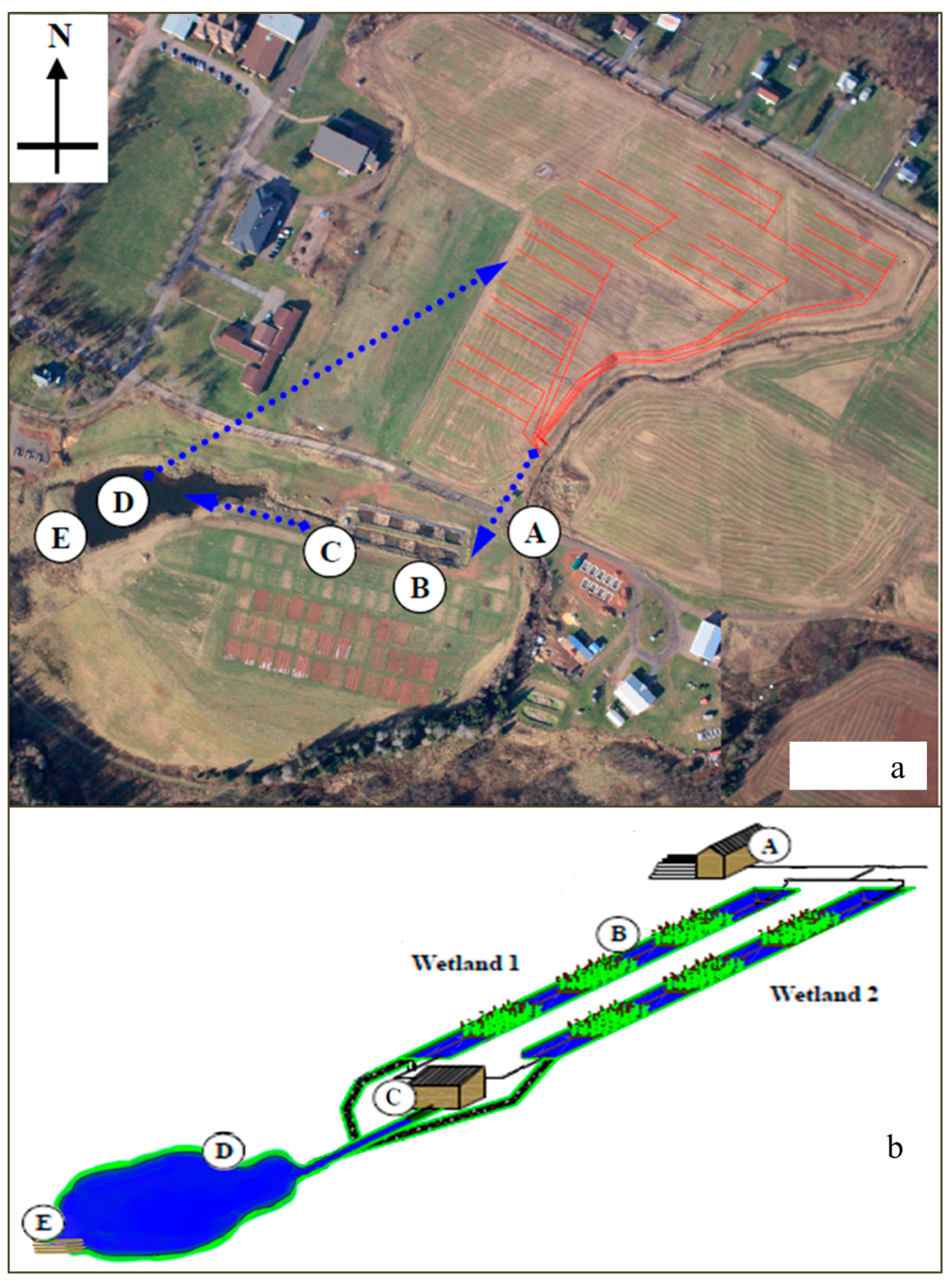
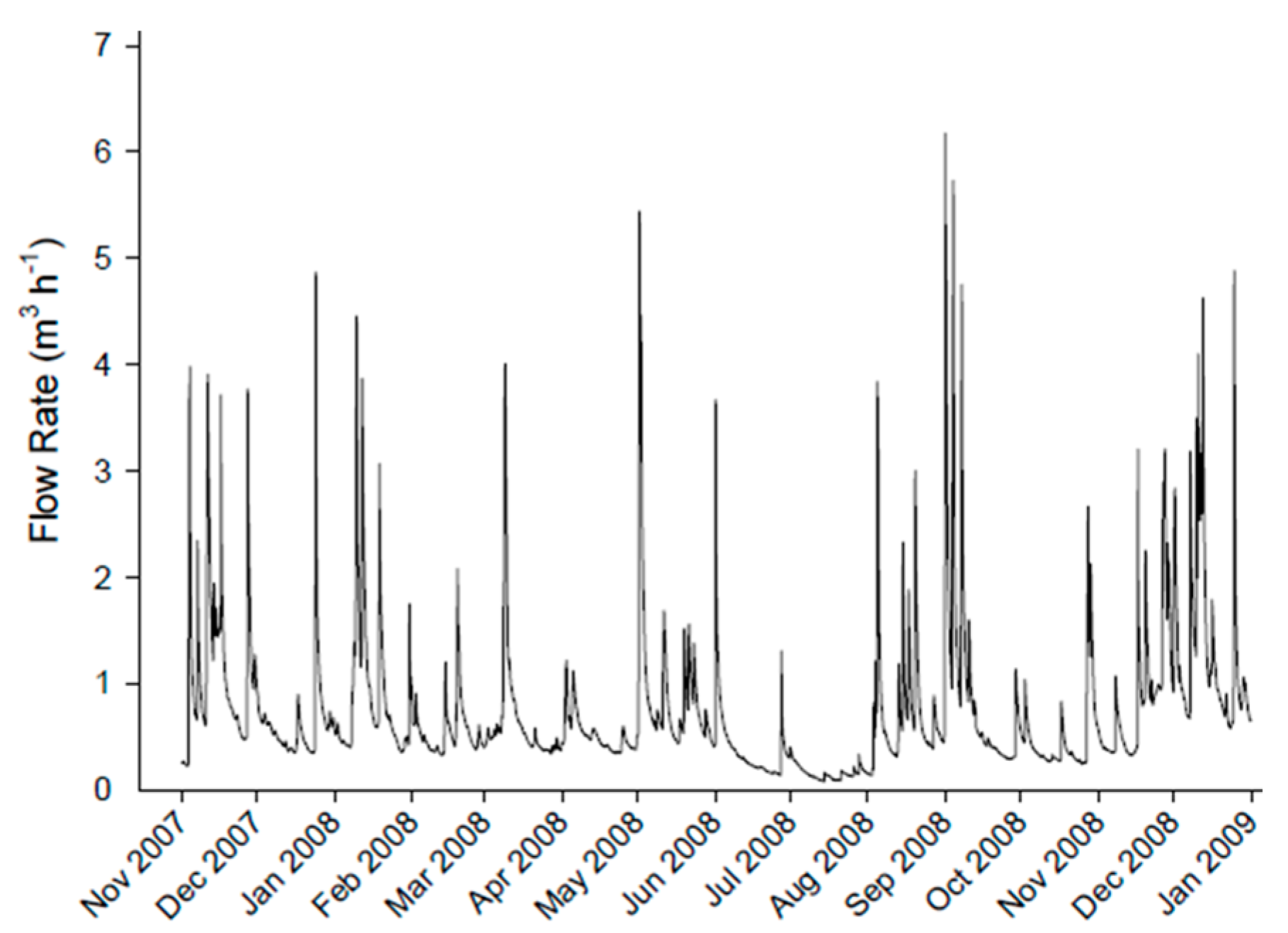
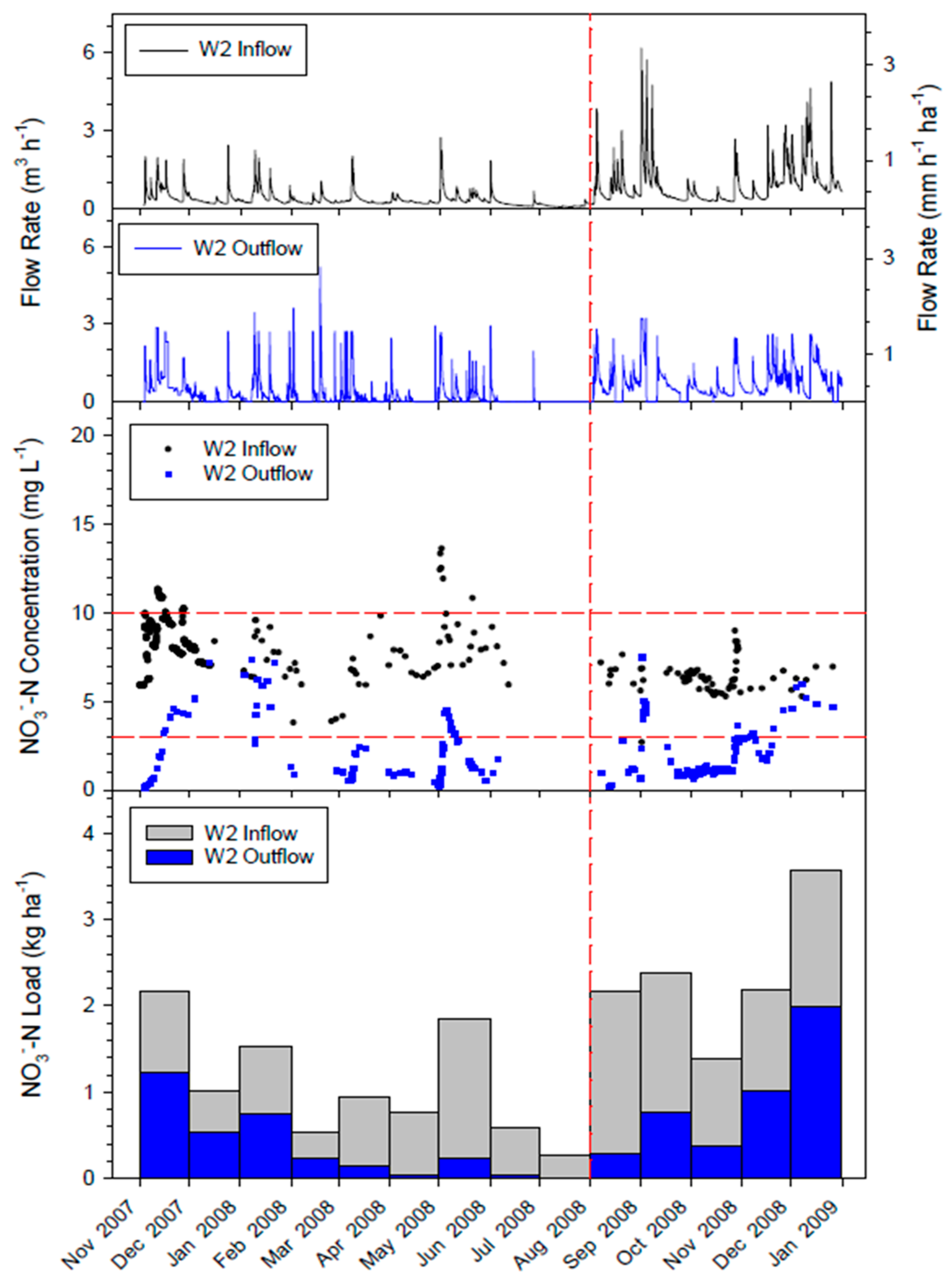
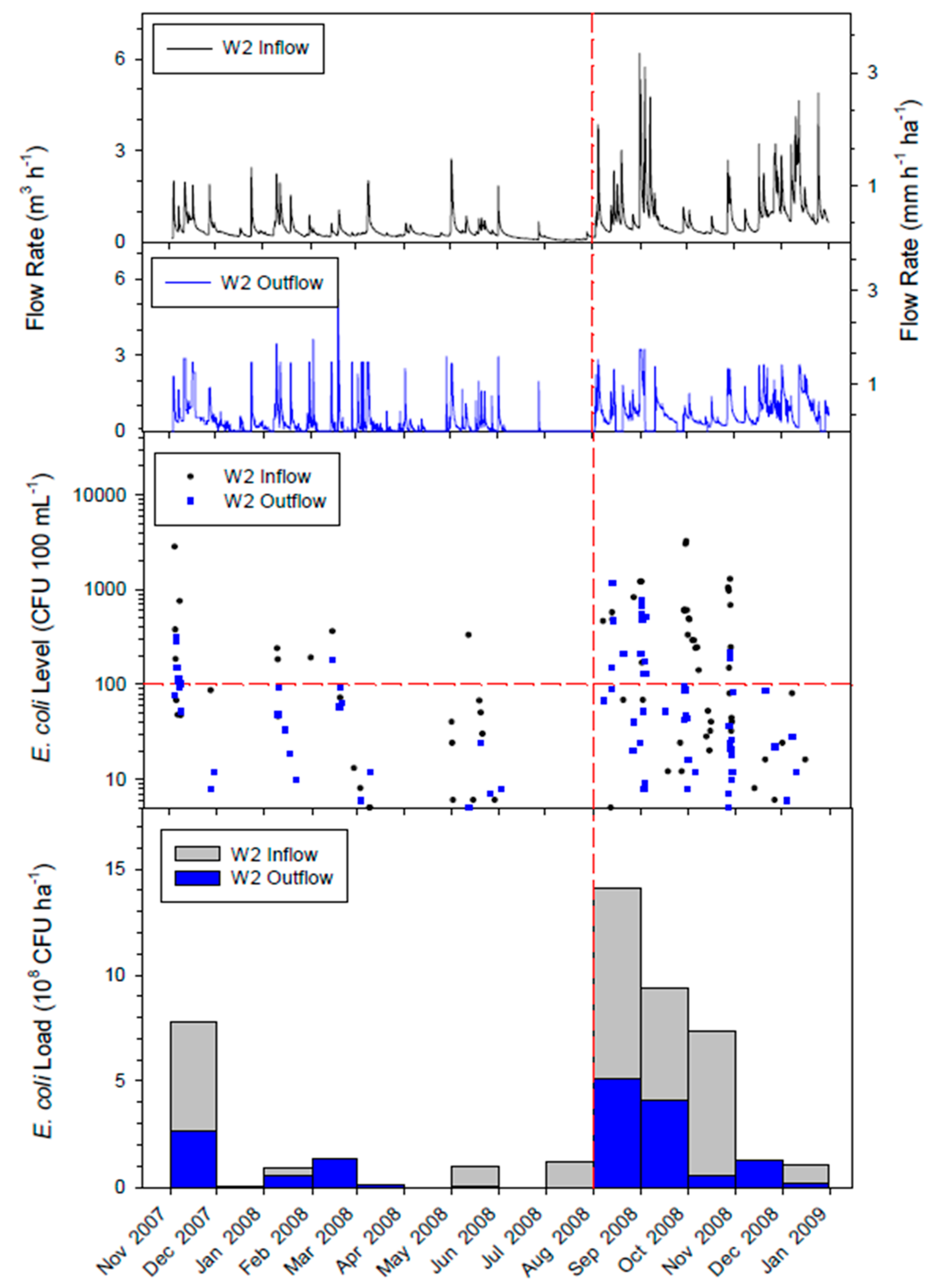
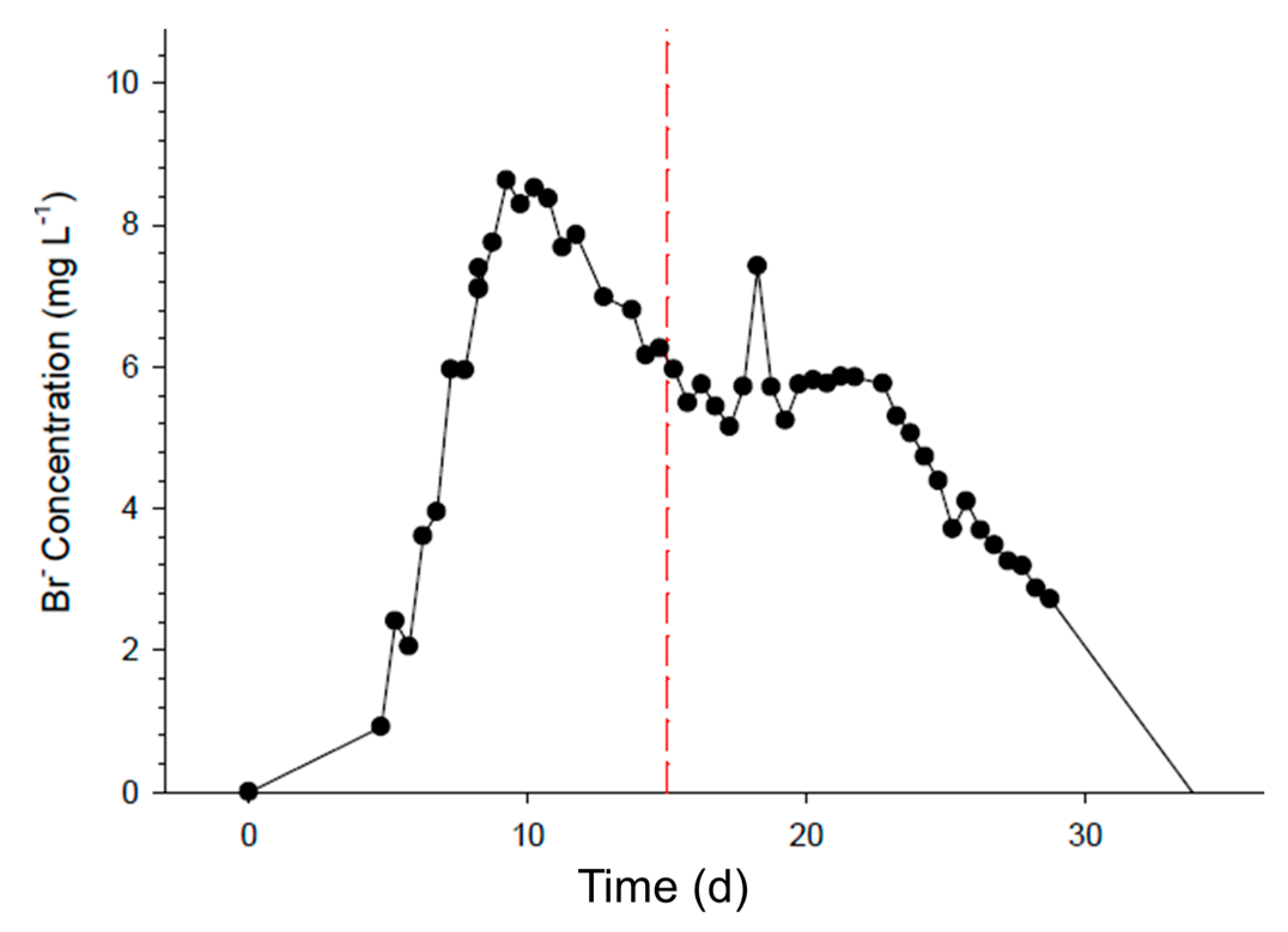
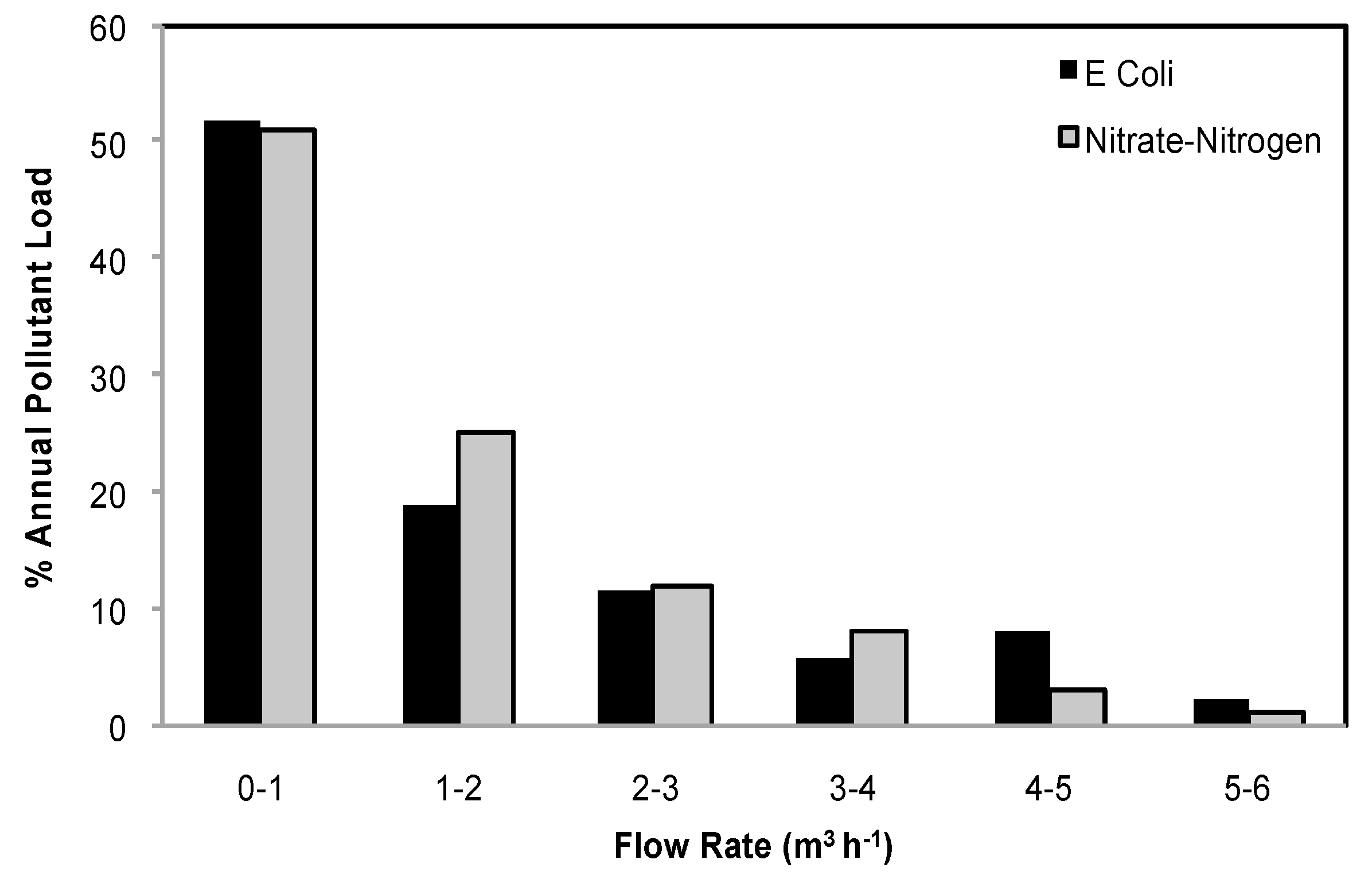
| Months | Precipitation | Temperature | Solar Radiation | ||
|---|---|---|---|---|---|
| (mm) | (mm) * | (°C) | (°C) * | (MJ m−2 d−1) | |
| November 2007 | 143 | 112 | 3 | 3 | 5 |
| December 2007 | 92 | 106 | –5 | −4 | 4 |
| January 2008 | 100 | 93 | −4 | −7 | 6 |
| February 2008 | 142 | 82 | −4 | −6 | 8 |
| March 2008 | 118 | 94 | −3 | −2 | 12 |
| April 2008 | 64 | 86 | 5 | 4 | 16 |
| May 2008 | 103 | 104 | 9 | 10 | 16 |
| June 2008 | 58 | 96 | 15 | 15 | 18 |
| July 2008 | 78 | 91 | 20 | 19 | 19 |
| August 2008 | 169 | 90 | 18 | 18 | 14 |
| September 2008 | 145 | 109 | 14 | 14 | 13 |
| October 2008 | 88 | 108 | 8 | 8 | 9 |
| November 2008 | 160 | 112 | 4 | 3 | 5 |
| December 2008 | 189 | 106 | −1 | −4 | 4 |
| Year | Crop Type | Manure Application Rate (t ha−1) |
|---|---|---|
| 2008 | Barley | 70 |
| 2007 | Soybeans | 20 |
| 2006 | Spring wheat | 85 |
| 2005 | Barley | 65 |
| 2004 | Soybeans | 25 |
| 2003 | Spring wheat | 25 |
| 2002 | Barley | 40 |
| 2001 | Soybeans | 23 |
| Wetland | Concentration Mean (Range) (mg L−1 or CFU 100 mL−1) | Load (kg ha−1) | Reduction (%) |
|---|---|---|---|
| NO3−-N inflow (n = 266) | 6.7 (2.68–13.6) | 18.1 | 67.4% |
| NO3−-N outflow (n = 390) | 2.2 (0.2–7.47) | 5.9 | |
| E. coli inflow (n = 231) | 122 † (0–3200) | 36.2 × 108 ‡ | 63.3% |
| E. coli outflow (n = 301) | 42 † (0–1160) | 13.3 × 108 ‡ | |
| Reservoir Out | |||
| NO3−-N (n = 55) | 1.21 (0.02–4.51) | ||
| E. coli (n = 64) | 178 † (0–2700) |
© 2017 by the authors. Licensee MDPI, Basel, Switzerland. This article is an open access article distributed under the terms and conditions of the Creative Commons Attribution (CC BY) license (http://creativecommons.org/licenses/by/4.0/).
Share and Cite
Haverstock, M.J.; Madani, A.; Baldé, H.; VanderZaag, A.C.; Gordon, R.J. Performance of an Agricultural Wetland-Reservoir-Irrigation Management System. Water 2017, 9, 472. https://doi.org/10.3390/w9070472
Haverstock MJ, Madani A, Baldé H, VanderZaag AC, Gordon RJ. Performance of an Agricultural Wetland-Reservoir-Irrigation Management System. Water. 2017; 9(7):472. https://doi.org/10.3390/w9070472
Chicago/Turabian StyleHaverstock, Michael J., Ali Madani, Hambaliou Baldé, Andrew C. VanderZaag, and Robert J. Gordon. 2017. "Performance of an Agricultural Wetland-Reservoir-Irrigation Management System" Water 9, no. 7: 472. https://doi.org/10.3390/w9070472





